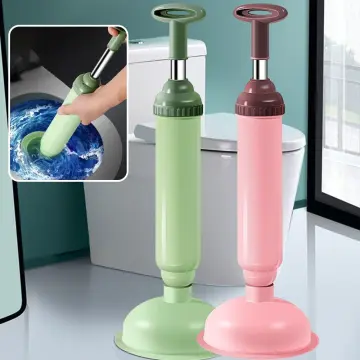We have stumbled upon the article relating to Tips on How to Effectively Use a Plunger listed below on the web and figured it made perfect sense to talk about it with you here.

Intro
Proper upkeep of household drains pipes is essential for avoiding obstructions and ensuring smooth water circulation. One of the key tools in every home owner's toolkit is the plunger, together with different drain cleansers developed to tackle stubborn clogs successfully. This post checks out how to utilize plungers and drainpipe cleaners successfully to keep your drains pipes moving freely.
Section 1: Recognizing Plungers
Types of Plungers
There are a number of sorts of plungers readily available, each designed for various types of drains and clogs. One of the most usual types include cup bettors, flange plungers, and accordion bettors.
How Plungers Work
Plungers work on the concept of developing stress and suction to remove obstructions. When appropriately used over a drain, they produce a vacuum that can take out debris or separate blockages.
Selecting the Right Plunger
Picking the appropriate plunger depends upon the type of drainpipe and the nature of the blockage. Cup bettors are perfect for sinks and bathtubs, while flange bettors are much better matched for commodes as a result of their layout.
Common Errors with Plungers
Preventing these errors ensures efficient plunging: inappropriate seal around the drain, inadequate pressure, and unclear surrounding debris.
Area 2: Utilizing Plungers Effectively
Prep work
Prior to plunging, ensure the bettor covers the drainpipe totally and develops a limited seal. Clear any kind of visible particles around the drainpipe opening.
Strategy
Start with mild plunging activities to construct suction. Boost stress gradually, utilizing a stable rhythm. Repeat as required up until the drain removes.
Troubleshooting Tips
If diving does not function, attempt changing the seal, using oil jelly for a much better seal, or utilizing a various kind of bettor.
Section 3: Understanding Drain Cleaners
Kinds Of Drain Cleansers
Drain pipes cleaners can be chemical or enzymatic. Chemical cleaners make use of solid chemicals to dissolve obstructions, while enzymatic cleaners use all-natural enzymes to break down raw material.
Just How Drain Cleaners Work
Chemical cleaners react with clogs to dissolve them, while enzymatic cleansers break down natural products like hair and oil without harming pipes.
Safety Considerations
Constantly put on handwear covers and eye defense when using chemical drain cleaners. Make certain ample ventilation and comply with maker guidelines carefully.
Eco-Friendly Alternatives
Take into consideration making use of vinegar and cooking soft drink or enzyme-based cleansers for eco-friendly choices that are more secure for pipes and the setting.
Area 4: Using Drainpipe Cleaners Efficiently
Application Strategies
Put chemical cleaners directly into the drain opening. Allow them to benefit the suggested time before flushing with warm water. Chemical cleaners need to rest overnight.
Precautions
Stay clear of blending different sorts of cleansers, as this can create toxic fumes. Never ever use chemical cleansers along with a bettor, as splashing can occur.
Dealing With Persistent Obstructions
For relentless obstructions, think about using a plumbing serpent or calling a specialist plumbing professional to avoid damage to pipes.
Verdict
Finally, comprehending exactly how to use bettors and drainpipe cleaners successfully is vital for maintaining healthy and balanced plumbing systems. By selecting the right devices and strategies, house owners can tackle small clogs and prevent major plumbing problems down the line.
4 DIY Ways to Unclog Drains
Wire Hanger
This age-old technique has been used by many an amateur plumber – to much success. Take any wire hanger, deconstruct its shape and leave a small hook shape on the end. Time to go fishing! Remove the shower or sink drain cover and snake the wire into the drain, wiggling and rotating it as you push it through. Dispose of the gunk that you remove and flush the drain with hot water. Rinse with a pan of boiling water for best results.
Plunger
Creating a suction in your drain can break up clogs caused by hair and soap residue build up. First, make sure you are using the correct type of plunger, one specifically for sinks or tubs. They are typically smaller than regular toilet plungers and often have a shallow suction cup. Regular plungers can work too but we’d recommend cleaning them first and finding a way to create better suction over the drain.
Baking Soda and Vinegar
This technique is a classic – and one of the most popular DIY drain unclog methods. Pour one cup of baking soda and one cup of vinegar down the drain and allow it to work its magic overnight. The next morning, flush the drain with boiling water. Repeat if necessary.
Drain Snake/Hair Clog Tool
If you know your clog is caused primary by hair, a drain snake/hair clog tool might be your best option. These tools can be purchased for under $10 at any hardware store and work well so long as the clog isn’t too deep in the drain.
https://www.callcatons.com/blog/four-diy-ways-to-unclog-drains/

I recently found that blog post about How To Use Your Toilet Plunger Correctly in 5 Easy Steps when scouting around the search engines. So long as you enjoyed our article please be sure to pass it around. Thanks so much for going through it.
Get Started
Comments on “Effective Plungers and Drain Cleaner: Essential Tips”